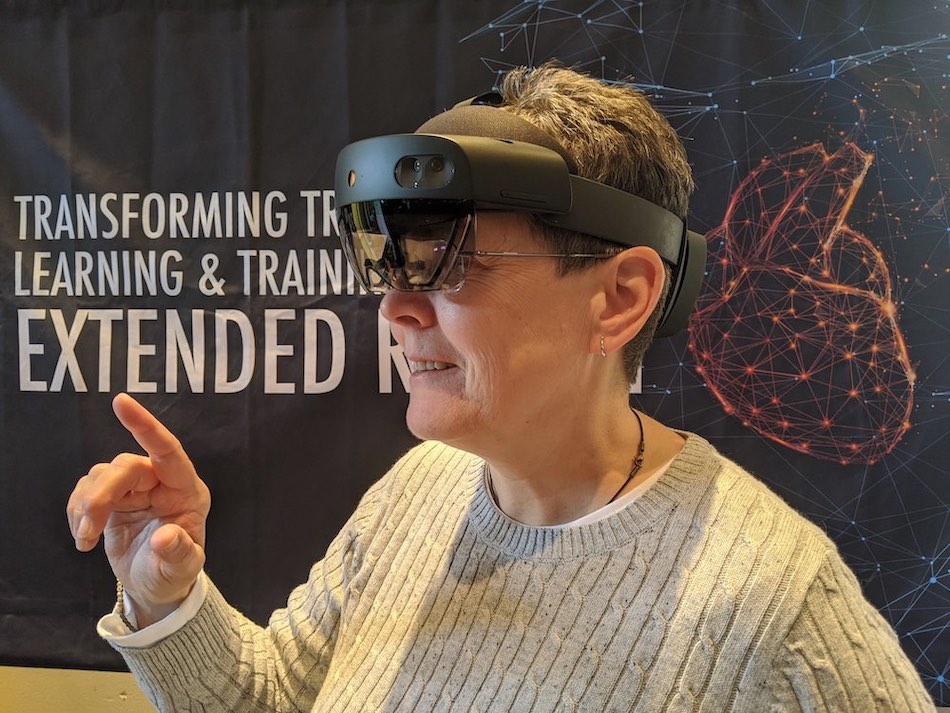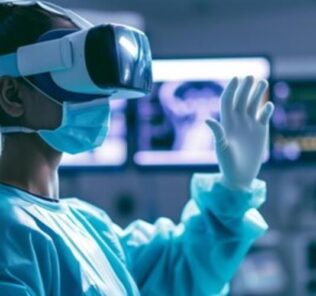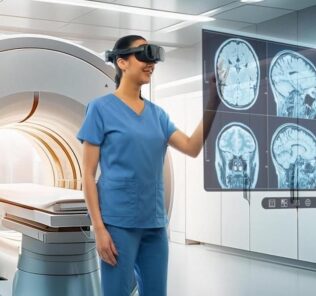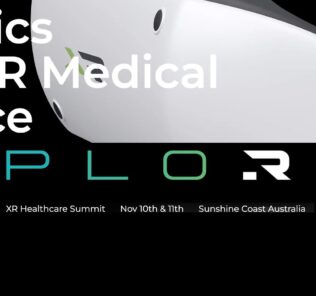Virtual Reality and Healthcare Symposium Day 2: Pain Management, VR Innovators & More
The second day of the VR and Healthcare Global Symposium opened today with a keynote from Dr. Brennan Spiegel, MD, MSHS, Director of Health Services Research, at Cedars-Sinai’s Health System and Founder of the Virtual Medicine conference. HealthySimulation.com covers his talk “Lessons Learned Using Virtual Reality in Clinical Practice” and shares more about the various vendors showcasing their innovative XR (mixed reality) learning systems. You can read Day 1’s coverage of the VR Voice conference here!
Dr. Brennan Spiegel Plenary on Lessons Learned from VR in Clinical Practice
Dr. Spiegel opened his talk sharing that his group has utilized VR with over 3,000 patients at Cedars-Sinai to help with pain management. By showing two unique Virtual Reality experiences, falling from a building and a mixed reality embodiment Near Death Experience (NDE) of floating above his body (Bourdin et al), Dr. Spiegel powerfully shared what hooked him to the realism of the medium. He explained that these experiences put him in a state of brain “flow” found during meditation or psychedelics where the sense of self has disintegrated.
Sponsored Content:
Sharing the research “A Deep-Dream Virtual Reality Platform for Studying Altered Perceptual Phenomenology”, Dr. Spiegel asked the audience to wonder “does VR act like Psilocybin”? Indeed through his own experiences with helping patients manage pain through Virtual Reality and supported by literature, VR certainly does reduce pain related brain activity, improving their lives almost immediately. He reminded us of Buddha’s words that there are two pains, the original injury and the psychological fear from that injury — and it appears that VR eases both!
“How does VR work to ease patient pain” Dr. Spiegel asked? First, he says it does obviously distract us from pain, but that is not all. Second, he believes that it gives our body the idea that it can “fight back”, giving our senses a perspective outside of itself providing our bodies a way to think differently. His studies have shown a 25% reduction in pain using VR versus 2D images for pain management.
He then shared other examples of VR’s opportunity to help patients in healthcare, with research focusing on hallucinations in people with psychosis, weight loss imagination, autism, dementia, and more. With so many applications, Dr. Spiegel is calling for a “VR Pharmacy”, which he started with the “VR-CORE model” for VR therapy development and validation which is available open access.
Sponsored Content:
He concluded his talk with a note about his new book, “VRX: How Virtual Therapeutics Will Revolutionize Medicine“. In VRx, Dr. Spiegel reveals a revolutionary new kind of care: virtual medicine. It offers the possibility of treating illnesses without solely relying on intrusive surgeries or addictive opioids. Virtual medicine works by convincing your body that it’s somewhere, or something, it isn’t. It’s affordable, widely available, and has already proved effective against everything from burn injuries to stroke to PTSD.
VR Medicine Conference: March 25th & 26th
Developed by the VR clinical research team at Cedars-Sinai Medical Center and Dr. Spiegel, with generous support from the Marc and Sheri Rapaport Fund for Digital Health Sciences and Precision Health, Virtual Medicine is a two-day symposium that convenes the brightest minds in immersive therapeutics. Attendees learn from case studies, didactic lectures, patient vignettes, and simulation workshops, to achieve its educational objectives. Learn more here!
FundamentalVR Democratizes Surgical Training Tools
Richard Vincent, Co-Founder and CEO of FundamentalVR gave a powerful presentation yesterday afternoon about the ability of Virtual Reality technologies to dramatically reduce medical errors in surgery because it provides:
- Safe, repeatable, measurable and scalable tools
- Confidence and competence building
- Data insights, learning pathways and analytics
- Objective understanding of skills
He shared recent validation in Virtual Reality in Medicine with the following research articles:
- 3D learning lowers the cognitive load
- Complex tasks performed quicker with haptics (Panait et al)
- Turning off haptics slows down motor skills learning muscle memory (Line et al)
- Expert surgeons achieved 78% blind drilling accuracy (Kusins et al)
Vincent believes we must be sure to understand the different levels of fidelity when it comes to haptics in VR, from low-fidelity wands to fidelity surgical simulator tools. Such feeling will help surgeons to better understand the tactile feelings of surgical interventions, such as drilling through a bone and knowing when to stop insertion based solely on feel.
Vincent explained how a robust multimodal education and surgical simulation platform, like the system available from FundamentalVR, enables educators to provide the strongest opportunity for skills development over time. A platform for learning which provides VR learning with tools that can be used at home, in the simulation lab and online, enables learners to engage with educational content in a dynamic range of fidelities in more ways. Simply put, the more opportunity learners have to engage with educational content beyond the simulation center the better their outcomes will be.
Vincent is confident that there is an unstoppable momentum towards precise measurement of medical skills and that by 2030 VR will be commonplace, expected and increasingly mandated. He urges the community to seek open standards and unified delivery.
HTC Vive VR Hardware Platform Supports Healthcare Developer Startups
Chris Chin, VP & General Manager of Vive Studios at HTC Vive, showcased about their Vive hardware technology support to developers working in healthcare simulation and education around the world. Teleport around boundless virtual worlds sitting at your desk, or create a dedicated room-scale play area where you can physically walk around. SteamVR Tracking provides the best experience possible, so play the way that works for you – seated, standing or room-scale. *An area of approximately 11’5’’ x 11’5’’. For the 3D VR Anatomy Atlas startup, they supported the company with early access to hardware and legal considerations for international distribution. He also shared briefly about Penumbra, a medical device company focused on stroke, via the REAL system which uses a bifocal headset for patient exercises for real-time therapy.
gigXR Expands Pearson’s AR Technologies
David King Lassman, CEO of gigXR, shared a presentation on “Enhancing Healthcare Learning & Training Through Extended Reality (XR) on HoloLens 2”. Designed to simulate, enhance and extend already existing pedagogical approaches, gigXR’s tools support active and collaborative learning, clinical simulation and visualization of 3D concepts. Techcrunch recently reported how private investors snagged Pearson’s AR assets with renewed investment into the technologies sharing “based in Los Angeles, GIGXR now owns flagship products including HoloPatient and HoloHuman, mixed reality training programs for medical schools that operate on the new HoloLens 2 headset.”
Polhemus Provides Motion Tracking in VR Healthcare
Pam Pelino, VP of Marketing & Sales at Polhemus, provided a presentation about motion tracking systems which can be used in Virtual Reality applications. The Polhemus system works by creating an electromagnetic field with a sensor acts as a kind of antenna, enabling for near real-time motion tracking as the sensor moves. Such sensor technology is used in medical simulators to track the position, angle, and motion of device components, such as with an ultrasound simulator probe. The company focuses in 4 key areas: Augmented Reality and Virtual Reality technologies, military applications, and healthcare education and training. In fact, many of the patient simulators our industry is familiar is utilizing Polhemus motion tracking sensors, but because of Non-Disclosure Agreements, we will never know it! Citing “Negative Feedback” training, Pam reminded the audience that by capturing the highest quality data sets for medical simulation experiences, fine improvements at the millimeter scale can be made over time to maximize learning outcomes. Launching the new Viper motion tracking system, the company now boasts sensor tracking at less than 1 millisecond!
Other Innovative VR Companies Present
VR Diagknowsis: VR Diagknowsis creates virtual reality games to help teach children with cancer about their diagnosis and treatment plan, improve communication with their clinical team, provide opportunities for pain reduction via distraction and connect kids with their peers.
Hatsumi VR BodyMap: Pain and emotions are still rarely understood, and often impossible to see or measure. Using drawing, painting and collage, Hatsumi VR BodyMap enables patients to make these invisible experiences visible enables the indescribable to be shared with others and thereby increases the understanding of another’s subjective experience. Importantly it also provides the creator with a new perspective on their own experience. Body mapping is an arts-based research tool, which, due to its focus on embodied experience, lends itself to the exploration of bodily and psychological feelings and experience. Body mapping involves tracing around a person’s body to create a life-sized outline, which is then filled in via a creative and reflective process, producing an image that reveals aspects of embodied experience.
SimX: SimX’s software replaces your physical simulation mannequins with a customizable, high-definition, 3D virtual patient that can be projected anywhere. Whether obese, pregnant, young, old, vomiting, missing limbs, bleeding, or expressing any number of other physical signs and symptoms, SimX’s software allows you to reproduce patient presentations with unprecedented visual fidelity. The SimX system works on the VR systems you already have. Whether on Gear VR, Sixense, or the HTC Vive SimX cases work seamlessly across all major platforms. Cases can be designed in VR or AR so you can train in the space where you work. The SimX team is committed to making sure the system remains compatible with cutting edge VR technology as it emerges.
Learn more on the VR Voice Website Today!
Lance Baily, BA, EMT-B, is the Founder & CEO of HealthySimulation.com, which he started while serving as the Director of the Nevada System of Higher Education’s Clinical Simulation Center of Las Vegas back in 2010. Lance is also the Founder and acting Advisor to the Board of SimGHOSTS.org, the world’s only non-profit organization dedicated to supporting professionals operating healthcare simulation technologies. His co-edited Book: “Comprehensive Healthcare Simulation: Operations, Technology, and Innovative Practice” is cited as a key source for professional certification in the industry. Lance’s background also includes serving as a Simulation Technology Specialist for the LA Community College District, EMS fire fighting, Hollywood movie production, rescue diving, and global travel. He and his wife Abigail Baily, PhD live in Las Vegas, Nevada with their two amazing daughters.
Sponsored Content:




















